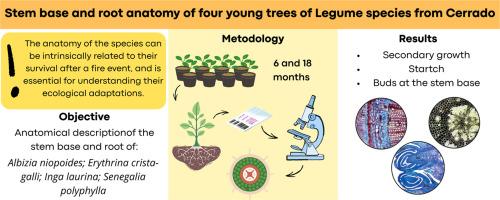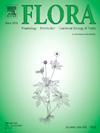塞拉多四种年轻豆科植物的茎基和根解剖:对火灾恢复能力的影响
IF 1.8
4区 生物学
Q3 ECOLOGY
引用次数: 0
摘要
豆科是塞拉多最具代表性的科之一,塞拉多是南美洲以火灾和干旱为特征的生物群系。这一生物群系中物种的解剖结构与它们在火灾事件后的生存有着内在的关系,对于理解它们的生态适应至关重要。本研究旨在描述4种豆科植物(Albizia niopoides、Erythrina crista-galli、Inga laurina和Senegalia polyphylla) 6月龄和18月龄时茎基部和根的解剖结构。为此,幼苗在温室中生长,然后将茎基部和根固定并脱水。一些样品用滑动切片机切割,另一些样品用旋转切片机切片。淀粉的存在用卢戈尔碘进行了验证。所有物种在6个月时都出现了次生生长,包括周皮的形成和物种特有的软木的发育。年龄之间的差异包括软木的增厚和/或木质化以及形成层带活动的变化。牛皮草和多叶草茎基部均有芽,说明其再生能力发育较早。在纤维、血管成分和薄壁射线的排列上,物种之间也存在解剖学上的差异。淀粉主要存在于次生木质部,其数量和分布随种龄的不同而不同。这些特征与在火灾和干旱等环境压力下的适应力有关。研究结果有助于了解易发生火灾的塞拉多生态系统中豆科植物幼苗的解剖可塑性和适应策略。本文章由计算机程序翻译,如有差异,请以英文原文为准。

Stem base and root anatomy of four young legumes from the Cerrado: Implications for fire resilience
Fabaceae is one of the most representative families of the Cerrado, a South American biome characterized by fire and drought. The anatomy of the species present in this biome is intrinsically related to their survival after a fire event, and is essential for understanding their ecological adaptations. This study aimed to describe the anatomical structure of the stem base and root of four native legume tree species (Albizia niopoides, Erythrina crista-galli, Inga laurina, and Senegalia polyphylla) at 6 and 18 months of age. For this purpose, the seedlings were grown in a greenhouse and then the stem base and root were fixed and dehydrated. Some samples were cut with a sliding microtome, and others were sectioned with a rotary microtome. The presence of starch was verified using Lugol's iodine. All species showed secondary growth even at 6 months, with periderm formation and species-specific cork development. Differences between ages included thickening and/or lignification of the cork and variations in the cambial zone activity. Buds were observed at the stem base of A. niopoides and S. polyphylla, suggesting early development of resprouting capacity. Anatomical differences were also noted in the arrangement of fibers, vessel elements, and parenchyma rays between species. Starch was detected mainly in the secondary xylem, varying in quantity and distribution between species and ages. These traits are linked to resilience under environmental stresses such as fire and drought. The findings contribute to understanding the anatomical plasticity and adaptive strategies of juvenile legumes in fire-prone Cerrado ecosystems.
求助全文
通过发布文献求助,成功后即可免费获取论文全文。
去求助
来源期刊

Flora
生物-植物科学
CiteScore
3.30
自引率
10.50%
发文量
130
审稿时长
54 days
期刊介绍:
FLORA publishes original contributions and review articles on plant structure (morphology and anatomy), plant distribution (incl. phylogeography) and plant functional ecology (ecophysiology, population ecology and population genetics, organismic interactions, community ecology, ecosystem ecology). Manuscripts (both original and review articles) on a single topic can be compiled in Special Issues, for which suggestions are welcome.
FLORA, the scientific botanical journal with the longest uninterrupted publication sequence (since 1818), considers manuscripts in the above areas which appeal a broad scientific and international readership. Manuscripts focused on floristics and vegetation science will only be considered if they exceed the pure descriptive approach and have relevance for interpreting plant morphology, distribution or ecology. Manuscripts whose content is restricted to purely systematic and nomenclature matters, to geobotanical aspects of only local interest, to pure applications in agri-, horti- or silviculture and pharmacology, and experimental studies dealing exclusively with investigations at the cellular and subcellular level will not be accepted. Manuscripts dealing with comparative and evolutionary aspects of morphology, anatomy and development are welcome.
 求助内容:
求助内容: 应助结果提醒方式:
应助结果提醒方式:


